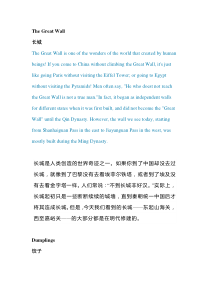 DOC
DOC
【文档说明】高中复习专题之16个英文传统文化素材.docx,共(14)页,26.380 KB,由小魏子文库上传
转载请保留链接:https://www.ichengzhen.cn/view-263749.html
以下为本文档部分文字说明:
TheGreatWall长城TheGreatWallisoneofthewondersoftheworldthatcreatedbyhumanbeings!IfyoucometoChinawithoutclimbingtheGreatWall,it's
justlikegoingPariswithoutvisitingtheEiffelTower;orgoingtoEgyptwithoutvisitingthePyramids!Menoftensay,"Hewhodoe
stnotreachtheGreatWallisnotatrueman."Infact,itbeganasindependentwallsfordifferentstateswhenitwasfirstbuilt,anddidnotbecomethe"GreatWall"unti
ltheQinDynasty.However,thewallweseetoday,startingfromShanhaiguanPassintheeasttoJiayunguanPassinthewest,wasmostlybuiltdu
ringtheMingDynasty.长城是人类创造的世界奇迹之一。如果你到了中国却没去过长城,就像到了巴黎没有去看埃菲尔铁塔,或者到了埃及没有去看金字塔一样。人们常说:“不到长城非好汉。”实际上,长
城起初只是一些断断续续的城墙,直到秦朝统一中国后才将其连成长城。但是,今天我们看到的长城——东起山海关,西至嘉峪关——的大部分都是在明代修建的。Dumplings饺子DumplingsareoneoftheChinesepeopl
e'sfavoritetraditionaldishes.AccordingtoanancientChineselegend,dumplingswerefirstmadebythemedicalsaint---ZhangZhongjing.Therearethreest
epsinvolvedinmakingdumplings:1)makedumplingwrappersoutofdumplingflour;2)preparethedumplingstuffing;3)makedumplingsandboilthem.Withthinandelasti
cdoughskin,freshandtenderstuffing,delicioustaste,anduniqueshapes,dumplingsarewortheatinghundredsoftimes.There'sano
ldsayingthatclaims,“Nothingcouldbemoredeliciousthandumplings”.DuringtheSpringFestivalandotherholidays,orwhentreatingrelat
ivesandfriends,Chinesepeopleliketofollowtheauspiciouscustomofeatingdumplings.ToChinesepeoplewhoshowhig
hreverenceforfamilylove,havingdumplingsatthemomenttheoldyearisreplacedbythenewisanessentialpartofbiddingfarewelltotheoldandusheringinthe
newyear.饺子是深受中国人民喜爱的传统食品。相传为古代医圣张仲景发明。饺子的制作是包括:1)擀皮、2)备馅、3)包馅水煮三个步骤。其特点是皮薄馅嫩,味道鲜美,形状独特,百食不厌。民间有“好吃不过饺子”的俗语。中国人接亲待客
、逢年过节都有包饺子吃的习俗,寓意吉利。对崇尚亲情的中国人来说,“更岁交子”吃饺子,更是欢度除夕、辞旧迎新必不可少的内容。ChineseChopsticks筷子TheChinesewayofeatingw
ithchopsticksisuniqueintheworld.Therecordedhistoryofchopsticksstartedmorethanthreethousandyearsago.Chopsti
ckswerenamedzhuinancientChinese.Theylookdeceptivelysimpletouse,butpossessmulti-variousfunctions,suchasclamping,turningover,liftingup,raking,stir
ring,scooping,poking,tearing,andsoon.ChopsticksweretakenasanauspiciousmascotbyordinarypeopleinancientChina.Forexample,thepartialtoneofchopstick
sisoftenusedbypeopleasametaphoratweddingstoindicateablessingorbenedictionforthecoupletohaveababysoon.Unlikeusingaknifeandforkorone's
ownhands,apairofchopsticksalsoimpliesthemeaningof“Harmonyiswhatmatters”.ChopsticksarehighlypraisedbyWesternersasahallmarkofancientorientalcivilizat
ion.中国人使用筷子就餐的方式在世界上独树一帜。有史记载用筷的历史已有三千多年。筷子古时称为箸,它看似简单,但却同时具有夹、拨、挑、扒、拌、撮、戳、撕等多种功能。中国民间视筷子为吉祥之物,如婚俗中将筷子隐喻为快生贵子的祝福等。与使用刀叉以及手抓的方式不同,成双结对
的筷子含有“和为贵“的意蕴。西方人赞誉筷子是古老的东方文明。Chinesekungfu中国功夫Chinesekungfu,orChinesemartialarts,carriestraditionalChinesecultureinabundance.ItisatraditionalChinese
sportwhichappliestheartofattackanddefenceincombatandthemotionsengagedwithaseriesofskillandtricks.ThecoreideaofChinesekingfuisderivedfromtheConfucian
theoryofboth“themeanandharmony”and“cultivatingqi”(otherwiseknownasnourishingone'sspirit).Meanwhile,italsoinclu
desthoughtsofTaoismandBuddhism.Chinesekungfuhasalonghistory,withmulti-varioussectsandmanydifferentboxingstyles,andemphasizescouplinghardness
withsoftnessandinternalandexternaltraining.Itcontainstheancientgreatthinkers'ponderingoflifeandtheuniverse.Theskillsinwieldingthe18kindsofweaponsn
amedbythelatergenerationsmainlyinvolvetheskillsofbare-handedboxing,suchasshadowboxing(Taijiquan),formandwillboxing(Xingyiq
uan),eighttrigrampalm(Baguazhang),andtheskillsofkungfuweaponry,suchastheskillofusingswords,spears,two-edgedswordsandhal
berds,axes,tomahawks,kooks,prongsandsoon.中国功夫即中国武术,是将技击寓于搏斗和套路运动之中的中国传统体育项目,承载着丰富的中国民族传统文化。其核心思想是儒家的中和养气之说,同时兼容了道家、释家的思想。中国武术源远流长、流派林立、拳种繁多,讲究刚柔并
济、内外兼修,蕴含着先哲们对生命和宇宙的参悟。后世所称十八般武艺,主要指:徒手拳艺,如太极拳、形意拳、八卦掌等;器械功夫,如刀枪剑戟、斧钺钩叉等。Chinesecharacters汉字Chinesecharacte
rswereinitiallymeanttobesimplepicturesusedtohelppeoplerememberthings.Afteralongperiodofdevelopment,itfinallybecameauniquecharacter
systemthatembodiesphoneticsound,image,idea,andrhymeatthesametime.Thewritingsystem,whichwasextremelyadvancedinancienttimes,beganw
ithinscriptionsonbonesandtortoiseshells,andtheseareregardedastheoriginalformsofChinesecharacters.Afterwards,Chinesecharacter
swentthroughnumerouscalligraphicstyles:bronzeinscriptions,officialscript,regularscript,cursivescript,runni
ngscript,etc.Chinesecharactersareusuallyroundoutsideandsquareinside,whichisrootedinancientChinesebeliefsofanorbicularskyandare
ctangularEarth.ThefivebasicstrokesofChinesecharactersare“一“(thehorizontalstroke)“丨”(theverticalstroke),“丿”(theleft-fall
ingstroke),“乀”(theright-fallingstroke),and“乛”(theturningstroke).汉字是从原始人用以记事的简单图画,经过不断演变发展,最终成为一种兼具音、形、意韵的
独特文字。现存中国古代最早成熟的文字是甲骨文,被认为是现代汉字的雏形。此后,汉字又经历了金文、隶书、楷书、草书、行书等不同的阶段。汉字结构“外圆内方“,源于古人”天圆地方“的观念。汉字有五种基本笔画,即:横、竖、撇、捺、折。Yangko秧歌Yangkoisoneoft
raditionfolkdanceofHaninChina.Itisusuallyperformedinnorthernprovinces.Thedancersusuallywearcolorfulandlightcostumes,andtheperformanceispowerfulan
drapid.DuringsomefestivalssuchasSpringFestival,LanteinFestival,ifpeoplehearthesoundofdrumandgong,nomatterhowcoldthewe
atheris,theywillcometostreetandappreciatetheYangko.Recentyears,theoldpeopleincityofeast-northernofChinaorganizedtheteamofYa
ngkobythemselves,theteamerskeeptheirhealthbydancingYangkothewholeyear.秧歌舞是中国汉族的一种民间传统舞蹈,通常在北方省份表演。秧歌舞者通常穿上明亮多彩的表演服装,他们的表演
动作有力迅速。在农历春节、元宵节等节日期间,人们一旦听到锣鼓声,不管外面天气有多冷,他们都会蜂拥到街上看秧歌舞表演。近年来,中国东北某些城市的老年人自发组织了了秧歌队,队员常年通过跳秧歌舞来保持健康,同时他们也乐在其中。Acupunctur
e针灸AcupunctureisanimportantpartoftraditionalChinesemedicine(TCM).Inaccordancewiththe“mainandcollateralchannels”theoryinTCM,thepurposeofacupunc
tureistodredgethechannelandregulateqiandblood,soastokeepthebody'syinandyangbalancedandachievereconciliationbetweenthein
ternalorgans.ItfeaturesintraditionalChinesemedicinethat“internaldiseasesaretobetreatedwithexternaltherapy”.The
maintherapyofacupunctureinvolvesusingneedlestopiercecertainacupointsofthepatient'sbody,oradoptingmoxibustiontostimulatethepatient’sacup
ointssoastostimulatethechannelsandrelievepain.Withitsuniqueadvantages,acupuncturehasbeenhandeddowngenerationaftergener
ationandhasnowspreadallovertheworld.Nowadays,acupuncture,alongwithChinesefood,kungfu(otherwiseknowna
sChinesemartialarts),andtraditionalChinesemedicine,hasbeeninternationallyhailedasoneofthe“fournewnationaltreasures.”针灸是中医学的重要组成部分。按照中医的经络理
论,针灸疗法主要是通过疏通经络、调和气血,来达到阴阳归于平衡,使脏腑趋于调和之目的。其特点是“内病外治”。主要疗法是用针刺入病人身体的一定穴位,或用艾火的温热刺激烧灼病人的穴位,以达到刺激经络。治疗病痛的
目的。针灸以其独特的优势,流传至今,并传播到了世界,与中餐、功夫、中药一起被海外誉为中国的“新四大国粹”。ChineseDragon龙DragontotemworshipinChinahasbeenaroundforthelast8,000ye
ars.TheancientsinChinaconsideredthedragon(orloong)afetishthatcombinesanimalsincludingthefish,snake,horseandoxwithcloud,thu
nder,lightningandothernaturalcelestialphenomena.TheChinesedragonwasformedinaccordancewiththemulticulturalfusionprocessoft
heChinesenation.TotheChinese,thedragonsignifiesinnovationandcohesion.对龙图腾的崇拜在中国大约已绵延了八千多年。中国龙是古人将鱼、蛇、马、牛等动物与云雾、雷电等自然天象集合而成的一种神物。中国龙的形成与中华民族的多元
融合过程同步。在中国人的心目中,龙具有振奋腾飞、开拓变化的寓意和团结凝聚的精神。ChineseBeijingOpera京剧Praisedas“OrientalOpera”,BeijingOperaisagenuinenationalquintessenc
eofChina.Itoriginatedfrommanykindsofancientlocaloperas,especiallyhuibaninsouthernChina.Attheendofthe19thCentury,Be
ijingOperaevolvedandtookshape,becomingthegreatestkindofoperainChina.BeijingOperaisablendofperformingarts---song,speech,performanc
e,acrobatixfightinganddance.BeijingOperaportraysandnarratestheplotandcharactersthroughstylizedacting.T
hemaintypesofrolesinBeijingOperaaresheng(male),dan(youngfemale),jing(paintedface,male),andchou(clown,maleorfemale).京剧被誉为“东方歌剧”,是
地道的中国国粹。它起源于中国多种古老的地方戏剧,特别是南方的“徽班”。到了19世纪末,京剧形成并成为中国最大的戏曲剧种。京剧是综合性表演艺术,集唱(歌唱)、念(念白)、做(表演)、打(武)、舞(舞蹈)为一体,通过程式化的表演手段,叙述故事,刻画人物。角色主要分生(男性)、旦(女性)、净(男性)、丑
(男性女性皆有)四大行当。ChineseIdioms中国成语Chineseidiomsrefertocomprehensiveandintegratedfixedphrasesandexpressions.Idiomsareestablishedandac
ceptedbyconstantusageandcommonpractice.Anidiomisalanguageunitthatislargerthanaword,buthasthesamegrammaticalfunctiona
saword.MostChineseidiomsconsistoffourcharacters.Forexample,ziqiangbuxi(makeunremittingeffortstoimproveoneself),qingchuyulan(bluert
hanindigo),andhoujibofa(successcomeswithtimeandeffort).Idiomsareextratedfromfolkproverbs,ancientworksoflite
rature,poems,fables,allusions,andwell-knownsayings.IdiomsareapartoftheChineselanguagethatareconciseandhavegreatvitality.中国成语是汉语中意义
完整的表示一般概念的固定词组或短语。“成语”中的“成”即是约定俗成。成语是比词大而语法功能又相当于词的语言单位。绝大多数的中国成语由四个汉字组成,例如:自强不息、青出于蓝、厚积薄发。成语主要从民间谚语、古代文学作品、诗歌、寓言、典故、名言警句等方面提炼而成,是汉语语言中精炼而
又富有生命力的一部分。Silk丝绸Chinaisthehomeofsilk.Mulberryplanting,sericulture,silkreelingandthickeningareallgreatinventionsoftheancientChinese.AsearlyastheSh
angandZhouDynasties(1600BC-256BC),theChinesepeople'ssilk-weavingtechniqueshadreachedanextremelyhighlevel
.DuringtheWesternHanDynasty(206BC-25AD),ZhangQian,anoutstandingdiplomat,travelledaroundcentralAsiaandconnectedChinawiththePers
ianGulfandtheMediterranean,openingupaneweraofSino-foreigntrade,exchangeandcommunication.Fromthenon,China'ssilkbecamewellknownfor
itsextraordinaryquality,exquisitedesignandcolor,andabundantcultureconnotations.Hitherto,Chinesesilkhasbeenaccep
tedasasymbolofChinesecultureandtheemissaryoforientalcivilization.中国是丝绸的故乡。栽桑、养蚕、缫丝、织绸是中国古代人民的伟大发明。商周时期丝绸的生产技术就已发展到相当高的水平。西汉时张骞通西域,把中原
与波斯湾、地中海紧密联系起来,开辟了中外交流贸易的新纪元。从此中国的丝绸以其卓越的品质、精美的花色和丰富的文化内涵闻名于世,成为中国文化的象征。东方文明的使者。ChineseClassicalGarden中国园林TheChinesecl
assicalgardenisaprecioustreasureofourancientChinesearchitecture.Itisakindofenvironmentart,whichsystematicallycombinesartific
ialmountainsandrivers,plantsandbuildingswiththenaturallandscape.TheconstructionstandardofaChineseclassicalgardenis“artificialasitis,thegardenm
ustlookingeniousandnatural.”WhenyougosightseeinginaChineseclassicalgarden,youshouldbeabletoappreciateitsartistic
conceptwhich“makesuseofthenaturallandscapetocreatetherealfunofmountainsandriversforviewers.”Oftheworld’sthreemajorgardensystems,theChin
eseclassicalgardenishailedasoneoftheoriginsoftheworld'sgardenduetoitslonghistoryandabundantconnotations.中国园林是把人造的
山水、植物、建筑等与自然地貌有机结合的环境艺术,是我国古代建筑艺术的珍宝。其建造原则是“妙极自然,宛自天开”。游赏中国古典园林,能充分领略“假自然之景,创山水真趣”的园林意境。在世界三大园林体系中,中国园林历史悠久、
内涵丰富,被誉为世界造园史上的渊源之一。TheFourTreasuresoftheStudy文房四宝Thewritingbrush,inkstick,inkstone,andpaperwererequisitetreasuresinthestudyofthescholarsofa
ncientChina,andtheyareoftenreferredtoasthe“FourTreasuresoftheStudy.”Thewritingbrushandinkstickhavebee
nusedbytheChinesetowriteandpaintsince5,000yearsago.IntheQinDynasty(221BC---206BC),peoplealreadyusedfeathersofdifferenth
ardnessandbambootrunkstomakebrushes.DuringtheHanDynasty(206BC-220AD),man-madeinkwasusedinsteadofnaturalink.AfterpaperwasinventedbytheChi
nese,bambooslips,woodentablets,brocadeandsilk,whichoriginallyfunctionedaswritingsurfaces,graduallyfadedout.Theinkstonewasfirstde
velopedwiththeuseofwritingbrushesandink.AftertheSongDynasty(960AD---1279AD),the“FourTreasureoftheStudy”particularly
referredtohubi,thewritingbrushproducedinHuzhou,Zhejiangprovince;huimo,theinkstickproducedinHuizhou,Anhuip
rovince;xuanpaper,akindofpaperproducedinXuanzhou,Anhuiprovince;andduanyan,theinkstonemadeinZhaoqing,Guangdongprovince(ZhaoqingwasearliercalledDua
nzhou).Indeed,theFourTreasuresoftheStudy”havewrittinthewholeChinesecivilization,asitis.笔墨纸砚是中国古代文人书房当中必备的宝贝,被称为“文房四宝”。用笔墨书写绘画在中国可追溯到五千年前。秦时
已用不同硬度的毛和竹管制笔;汉代以人工制墨替代了天然墨;有了纸张以后,简牍锦帛逐失其用;砚台则随笔墨的使用而发展。“文房四宝”到宋朝以后特指湖笔、徽墨、宣纸、端砚。可以说文房四宝书写了整个中华文明。ChineseSeal印章Asealcanalsobedef
inedasastamp.BoththeChineseofficialandprivatesealofvariousdynastieshavedifferenttitles,suchasstamp,zhu
note,contract,fu,leaseandothers.ThesealsusedbytheemperorsofancientChinawerecalledxi,yin,bao,etc.Accordingtohistoricalrecords,sealsw
erewidelyusedduringtheWarringStatesPeriod(475BC-221BC).Themakingofasealistoengravefonts,suchassealcharactersandofficialscriptandsoon;
orimagesintheformofintaglioandembossmentintotheseal,basicallyshapedasroundorsquare.Coveredwithavermilio
noverlay,theChinesesealisnotonlyusedindailylife,butitisalsousedtorepresentsignaturesonpaintingsandcall
igraphies.ItisgraduallybecomingoneofChina'suniqueartworks.印章就是图章。中国历代官、私所用的印章有印信、朱记、合同、符、契等等不同的称谓,而帝王所用的印章古时称玺、印、宝、章等。据史料记载
,印章在战国时代已普遍使用。印章的制作是将篆隶等字体、图像用阴、阳的形式雕刻而成,形状以圆、方为主。印章用朱色钤盖,除日常应用外,又多用于书画题识,逐渐成为中国特有的艺术形式之一。ChineseEra天干地支TheChineseeraisthesymboltha
ttheChinesecalendarusesforrecordingandnamingyears.ThetenHeavenlyStemsare:jia,yi,bing,ding,wu,ji,geng,xin,ren,gui.ThetwelveEarthlyB
ranchesare:zi.chou,yin,mou,chen,si,wu,wei,shen,you,xu,hai.Afterobservingthelunarmonth,theancientsfoundthatthemoonalwa
yswazesandwanesroughly12timesayear,andtwolunarmonthsaccountforabout60days,sotheorderofthetenHeavenlySte
msandtheorderofthetwelveEarthlyBranchesareproperlymatchedinturn.Intermsofrecordingdate,60yearsisconsideredtobeafulltimecycle.TheChineseerachronology
wasfirstinventedinancienttimesandisstillinusenow.天干地支是中国历法中用以记录和命名年岁的方法。十天干为:甲、乙、丙、丁、戊、已、庚、辛、壬、癸;十二地
支为:子、丑、寅、卯、辰、巳、午、未、申、酉、戊、亥。古人观测朔望月,发现月亮圆缺12次大体上是一年的天数,而两个朔望月约是60天。古人以十天干与十二地支的顺序依次相配,记录不同年份,60年为一个轮回。干支纪年法从古沿用至今。
 辽公网安备 21102102000191号
辽公网安备 21102102000191号
 营业执照
营业执照